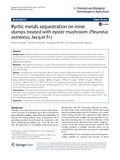Please use this identifier to cite or link to this item:
https://cris.library.msu.ac.zw//handle/11408/2918Full metadata record
| DC Field | Value | Language |
|---|---|---|
| dc.contributor.author | Masaka, Johnson | - |
| dc.contributor.author | Mutambu, Marshall | - |
| dc.contributor.author | Mhindu, Rangarirayi | - |
| dc.contributor.author | Muringaniza, Kudakwashe | - |
| dc.date.accessioned | 2017-10-24T19:40:12Z | - |
| dc.date.available | 2017-10-24T19:40:12Z | - |
| dc.date.issued | 2017 | - |
| dc.identifier.issn | 2196-5641 | - |
| dc.identifier.uri | https://doi.org/10.1186/s40538-017-0108-6 | - |
| dc.identifier.uri | http://hdl.handle.net/11408/2918 | - |
| dc.description.abstract | Background Mining activities can lead to the generation of large quantities of heavy metal laden wastes which are released into the environment in an uncontrolled manner, causing widespread contamination of the ecosystem. Bioremediation is an innovative and promising technology available for removal and recovery of heavy metals from polluted environments. Methods Field experiments based on a Latin Square Design were employed in this study in order to determine the effectiveness of oyster mushroom (P. ostreatus) as a bioremediation agent for the sequestration of pyritic heavy metals from mine dumps. Results Compared with the background values of heavy metals in virgin forest soil, concentrations of Mn2+; Cr2+; Pb2+; Fe3+; and Cd2+ were substantially enriched in the study sites. The propagation of oyster mushroom in wheat straw substrate and heavy metal-polluted pyritic mine waste, reduced considerably the concentrations of mobile heavy metals in the waste by 1.2 mg kg−1 (98%); 2.0 mg kg−1 (79%); 13.1 mg kg−1 (93%); 7.7 mg kg−1 (78%); and 6.5 mg kg−1 (88%) for Mn2+; Cr2+; Pb2+; Fe3+; and Cd2+, respectively. Results have shown that the greatest threat to the ecology in the mine dump sites is currently posed by Cd2+; Fe3+; and Pb2+, while the least ecological threat comes from the concentrations of Mn2+. Conclusions The mean levels of reductions in heavy metal concentrations in pyritic mine waste after mycoremedial interventions observed in the current study clearly indicate that, in bio-sorption, P. ostreatus is more efficient in sequestering Mn2+; Fe3+; and Cd2+, in that order. The oyster mushroom is less efficient in the bio-sorption of Cr2+ and Fe3+ from heavy metal polluted mine waste. | en_US |
| dc.language.iso | en | en_US |
| dc.publisher | Springer Verlag | en_US |
| dc.relation.ispartofseries | Chemical and Biological Technologies in Agriculture;Vol. 4, No. 26; p. | - |
| dc.subject | Contamination | en_US |
| dc.subject | Mine dumps | en_US |
| dc.subject | Bioremediation | en_US |
| dc.subject | Oyster mushroom | en_US |
| dc.title | Pyritic metals sequestration on mine dumps treated with oyster mushroom (Pleurotus ostreatus, Jacq.et Fr.) | en_US |
| dc.type | Article | en_US |
| item.fulltext | With Fulltext | - |
| item.grantfulltext | open | - |
| item.openairetype | Article | - |
| item.cerifentitytype | Publications | - |
| item.languageiso639-1 | en | - |
| item.openairecristype | http://purl.org/coar/resource_type/c_18cf | - |
| Appears in Collections: | Research Papers | |
Files in This Item:
| File | Description | Size | Format | |
|---|---|---|---|---|
| Masaka_et_al-2017-Chemical_and_Biological_Technologies_in_Agriculture.pdf | Full Text | 2.54 MB | Adobe PDF |  View/Open |
Page view(s)
144
checked on Nov 23, 2025
Download(s)
22
checked on Nov 23, 2025
Google ScholarTM
Check
Items in MSUIR are protected by copyright, with all rights reserved, unless otherwise indicated.



